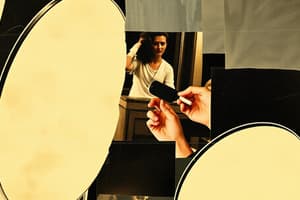Podcast
Questions and Answers
What is the purpose of fitting convex mirrors as rear-view mirrors in vehicles?
What is the purpose of fitting convex mirrors as rear-view mirrors in vehicles?
- To increase magnification of objects behind the vehicle
- To reduce the field of view for better focus on objects
- To provide a larger field of view and always give an erect image (correct)
- To make objects appear smaller and inversely oriented
Which mirror is commonly used in vehicles for rear-view purposes?
Which mirror is commonly used in vehicles for rear-view purposes?
- Convex mirror (correct)
- Concave mirror
- Plane mirror
- Diverging mirror
Why does a convex mirror always give an erect image?
Why does a convex mirror always give an erect image?
- Due to its ability to converge light rays
- Due to its ability to diverge light rays
- Due to its outward curvature (correct)
- Due to its inward curvature
Which mirror can give an erect and enlarged image of an object?
Which mirror can give an erect and enlarged image of an object?
What is the principal focus of a concave mirror?
What is the principal focus of a concave mirror?
If the radius of curvature of a spherical mirror is 20 cm, what is its focal length?
If the radius of curvature of a spherical mirror is 20 cm, what is its focal length?
Which material cannot be used to make a lens?
Which material cannot be used to make a lens?
Where should an object be placed in front of a convex lens to get a real image of the size of the object?
Where should an object be placed in front of a convex lens to get a real image of the size of the object?
If an image formed by a concave mirror is observed to be virtual, erect, and larger than the object, where should be the position of the object?
If an image formed by a concave mirror is observed to be virtual, erect, and larger than the object, where should be the position of the object?
If both a spherical mirror and a thin spherical lens have a focal length of -15 cm, what are they likely to be?
If both a spherical mirror and a thin spherical lens have a focal length of -15 cm, what are they likely to be?
No matter how far you stand from a mirror, your image appears erect. What type of mirror is likely being used?
No matter how far you stand from a mirror, your image appears erect. What type of mirror is likely being used?
Which lens would you prefer to use when reading small letters found in a dictionary?
Which lens would you prefer to use when reading small letters found in a dictionary?
What happens to the image of the pencil in the mirror when it is moved away slowly?
What happens to the image of the pencil in the mirror when it is moved away slowly?
In the ray diagrams for a convex mirror, where is the position of the image when the object is at infinity?
In the ray diagrams for a convex mirror, where is the position of the image when the object is at infinity?
What is the nature of the image formed by a convex mirror when the object is between infinity and the pole P?
What is the nature of the image formed by a convex mirror when the object is between infinity and the pole P?
Which mirror will give the full image of a large object?
Which mirror will give the full image of a large object?
What happens to the image size when an object moves towards infinity in a convex mirror?
What happens to the image size when an object moves towards infinity in a convex mirror?
What is the nature of the image formed by a convex mirror when the object is at infinity?
What is the nature of the image formed by a convex mirror when the object is at infinity?
Study Notes
Mirrors and Lenses
- Convex mirrors are used as rear-view mirrors in vehicles because they provide a wider field of view and a smaller image, reducing blind spots.
- Convex mirrors are commonly used in vehicles for rear-view purposes.
- Convex mirrors always give an erect image because they are diverging lenses that reduce the size of the image.
Mirror Properties
- A convex mirror can give an erect and diminished image of an object.
- The principal focus of a concave mirror is the point at which parallel rays intersect.
- If the radius of curvature of a spherical mirror is 20 cm, its focal length is 10 cm (since focal length = radius of curvature / 2).
Lenses
- No material can be used to make a lens, but some materials (like wood or paper) are not suitable due to their opacity or lack of transparency.
- To get a real image of the same size as the object with a convex lens, the object should be placed at a distance of twice the focal length from the lens.
Image Formation
- If an image formed by a concave mirror is virtual, erect, and larger than the object, the object is between the focus and the pole of the mirror.
- If both a spherical mirror and a thin spherical lens have a focal length of -15 cm, they are likely to be concave (since negative focal length indicates divergence).
Mirror Types
- If an image appears erect regardless of the distance from the mirror, a convex mirror is likely being used.
- A convex lens is preferred for reading small letters found in a dictionary because it can magnify text.
Image Characteristics
- When an object is moved away slowly from a mirror, its image appears to move closer to the mirror.
- In ray diagrams for a convex mirror, the image is at infinity when the object is at infinity.
- When an object is between infinity and the pole P of a convex mirror, the image is virtual, erect, and smaller than the object.
- A concave mirror is better suited for observing a large object, as it can provide a full image.
- When an object moves towards infinity in a convex mirror, the image size decreases.
- When an object is at infinity, a convex mirror forms a virtual, erect, and highly diminished image.
Studying That Suits You
Use AI to generate personalized quizzes and flashcards to suit your learning preferences.
Description
This quiz explores the concepts of light reflection and refraction, specifically focusing on the formation of images using different types of mirrors like plane mirrors, concave mirrors, and convex mirrors. Test your understanding of how different mirrors affect the size and orientation of images formed.




